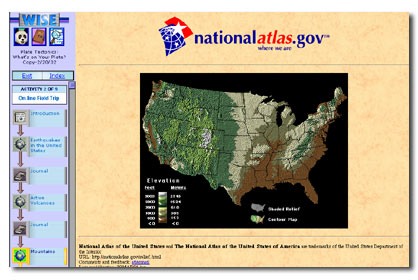Research Goals and Outcomes | Research Design | Results
Research Design
In two large scale implementations of Making Thinking Visible (2001, 2002), middle and high school students from California and Massachusetts collaborated on line using the "What's on Your Plate?" Curriculum in WISE (Web-based Inquiry Science Environment developed by Marcia Linn & her WISE team at UC-Berkeley).
 Pre-Instruction data
Pre-Instruction data
We collected data concerning students' pre-instruction models of the inside of the earth and of the causal mechanisms underlying plate tectonic phenomena using previously developed methods and protocols (Gobert, 2000).
Epistemology data
We collected data concerning students' epistemologies of science and of scientific models using previously developed methods and protocols (Gobert & Discenna, 1997; Grosslight et al, 1991).
Data on Classroom Activities
We have data on classroom activities from all classes including:
- Students' journal notes on what they already knew about the differences between west and east coast geology.
- Students' models and corresponding explanations of earthquakes or volcanoes (West coast students only) and students' models and corresponding explanations of mountain formation (East coast students only),
- Students' summary notes from their on-line field trip where they "visited" web sites of real time data about mountain ranges, volcanoes, and earthquakes in the U.S.
- Students' self-reflective questions, the task was as follows: "Write one (or two) question(s) you have about plate boundaries or plate movement that will help you better understand why the geologic processes on the West and East coasts are different."
- Students' reflection notes about more detailed information about the causal mechanisms underlying plate tectonics (convergent boundaries, divergent boundaries, transform boundaries, and mantle convection).
- Students' critiques of their learning partners' models from the opposite coast.
- Students' revised models and revised explanations, as well as their justifications for changes to their models.
- Students' answers and analysis to their self-reflective questions which they posed and their discourse in each of four on-line forums (mountains, volcanoes, earthquakes, and plate characteristics).
- Students' responses to anomalous data regarding plate tectonics, e.g.,"How can there be mountains on the East coast when there is no active boundary there?"
Post-Test Data
We have students' post unit knowledge surveys about plate tectonics and its underlying causal mechanisms and students' post unit surveys about the nature and purpose of models in science. The post-test knowledge survey is the same as the pre-test.

